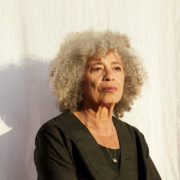Before the world knew what intersectionality was, the scholar, writer and activist was living it, arguing not just for Black liberation, but for the rights of women and queer and transgender people as well.
— NELSON GEORGE | THE GREATS, THE NEW YORK TIMES
THERE’S A WALL on Throop Avenue in Bedford-Stuyvesant, Brooklyn, that is painted with a mural of Black icons. It begins with Bob Marley and Haile Selassie before going on to include Martin Luther King Jr., Betty Shabazz (Betty X) and Nelson Mandela. The last portrait is of Angela Yvonne Davis — scholar, activist and the only surviving hero of the global African diaspora. Davis’s image is painted from a photograph taken in the early ’70s, when she became a symbol of the struggle for Black liberation, anticapitalism and feminism. It’s a powerful portrait — she is wearing her hair in a round, black Afro, her hand curled as if she’s making a rhetorical point. Her expression is pensive, intelligent, challenging.
For the mural’s context, we have to return to the fall of 1969, when Davis, then an assistant professor in the philosophy department at the University of California, Los Angeles, was fired at the beginning of the school year for her membership in the Communist Party, and then, after a court ruled the termination illegal, fired again nine months later for using “inflammatory rhetoric” in public speeches. She had recently become close to a trio of Black inmates nicknamed the Soledad Brothers (after the California prison in which they were held) who had been charged with the murder of a white prison guard in January 1970. One, George Jackson, was an activist and writer whom Davis befriended upon joining a committee challenging the charges. In August 1970 — after Jackson’s younger brother, Jonathan, used firearms registered to Davis in a takeover of a Marin County courthouse that left four people dead — Davis immediately came under suspicion. In the aftermath of that bloody event, she was charged with three capital offenses, including murder.
Overnight, she became an outlaw. Within two weeks of the shootout, J. Edgar Hoover placed Davis on the F.B.I.’s Ten Most Wanted list, making her the third woman ever to be included. A national manhunt ensued before she was detained two months later in a New York motel. President Nixon congratulated the bureau on capturing “the dangerous terrorist Angela Davis.” After her arrest, the chant “Free Angela!” became a global battle cry as the academic — who had studied philosophy in East and West Germany in the late ’60s and had been a vocal supporter of the Black Panthers and the anti-Vietnam War movement — became widely viewed on the left as a political prisoner. She spent 18 months in jail before being found not guilty on all charges.
— Credits
Featured Image, John Edmonds
Full article @ The New York Times
— Related
Black Lives Matter (BLM) is a decentralized political and social movement advocating for non-violent civil disobedience in protest against incidents of police brutality and all racially motivated violence against black people. The broader movement and its related organizations typically advocate against police violence towards black people, as well as for various other policy changes considered to be related to black liberation.
In July 2013, the movement began with the use of the hashtag #BlackLivesMatter on social media after the acquittal of George Zimmerman in the shooting death of African-American teen Trayvon Martin 17 months earlier, in February 2012. The movement became nationally recognized for street demonstrations following the 2014 deaths of two African Americans: Michael Brown—resulting in protests and unrest in Ferguson, Missouri, a city near St. Louis—and Eric Garner in New York City. Since the Ferguson protests, participants in the movement have demonstrated against the deaths of numerous other African Americans by police actions or while in police custody. In the summer of 2015, Black Lives Matter activists became involved in the 2016 United States presidential election. The originators of the hashtag and call to action, Alicia Garza, Patrisse Cullors, and Opal Tometi, expanded their project into a national network of over 30 local chapters between 2014 and 2016. The overall Black Lives Matter movement is a decentralized network of activists with no formal hierarchy.
Source – Black Lives Matter (Updated: 18 October 2020) Wikipedia. Available at https://en.wikipedia.org/wiki/Black_Lives_Matter, (Accessed: 20 October 2020)

